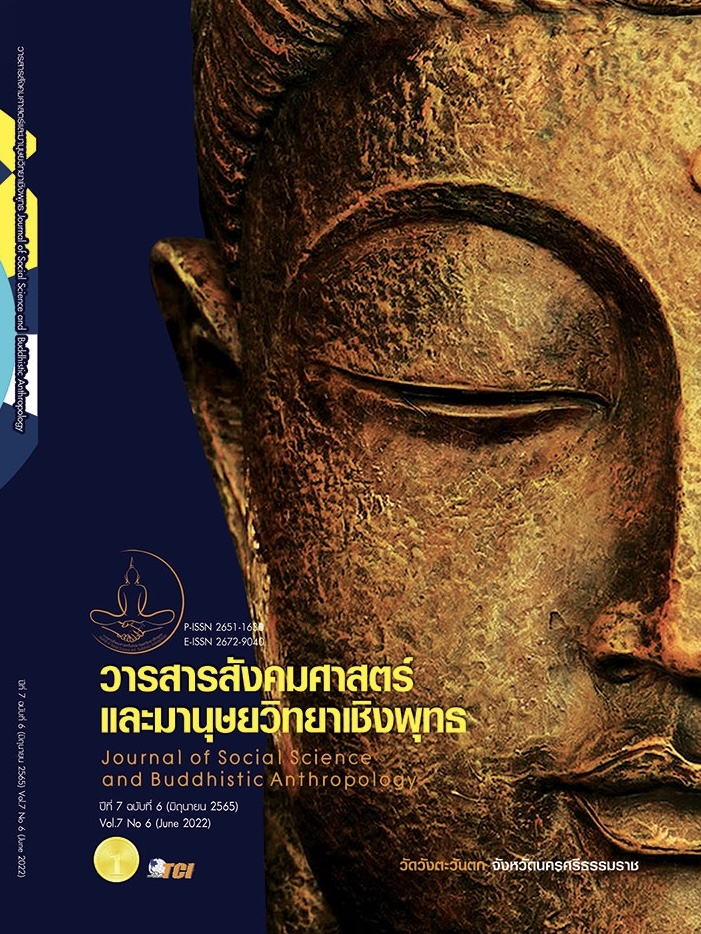FOLKTALES RELATED TO DIMENSIONS OF INTERPRETATION OF CULTURE, CULTURAL ECOLOGY, AND ARCHEOLOGICAL SITES
Keywords:
Folktales, Cultural Ecology, Archaeological SiteAbstract
The objectives of this research article were to study folktales related to dimensions of interpretation of culture, cultural ecology, and archaeological sites. The method of study is a mixed method. For qualitative research, the researcher is a tool who collected data through in-depth interviews and participant observations. There were 50 key informants. Researcher collected information in communities around the archaeological sites between January 2018 - February 2019. Qualitative Data Analysis involved a Triangular Content Analysis Table to review and synthesize 50 interviews with connotation of values and traditions, written with the Thick Description technique. There were 15 folktales found after the process. The researcher used the interview text to create a 50-item questionnaire and then conducted a survey of 500 Thai people. For quantitative data analysis, Factor Analysis technique was used to extract variables and then determined the Eigen value by rotating the axis with Orthogonal Rotation (Varimax). Then, each factor was given name to. There are 4 factors that had Eigen Value greater than 1: 1) 15 Folktales related to Buddhist archaeological sites 2) Folktale language is the key to propagating Buddhism and forming good Buddhists 3) Folktales are related to cultural ecology 4) Folktales and folklore are related to cultural interpretations. The result showed that all 15 folktales are contemporary tales which share the cultural ecology in Southeast Asia and reflect the folklore of Southeast Asia. These 15 folktales are related to cultural interpretation, cultural ecology, and archaeological sites. The language of folktales is the key to spreading Buddhism.
References
กุหลาบ มัลลิกะมาส. (2516). คติชาวบ้าน. กรุงเทพมหานคร: สมาคมภาษาและหนังสือแห่งประเทศไทยฯ.
นายสุลิจัก แสงทอง. (15 ตุลาคม 2559). เทคโนโลยีบุญบั้งไฟและนิทานพื้นบ้านเรื่องผาแดงนางไอ่. (ธีติมา พนมเสริฐ, ผู้สัมภาษณ์)
พระพรหมคุณาภรณ์ ป.อ.ปยุตโต. (2599). พจนานุกรมพุทธศาสตร์ ฉบับประมวลธรรม. (พิมพ์ครั้งที่ 34). กรุงเทพมหานคร: มูลนิธิการศึกษาเพื่อสันติภาพพระธรรมปิฎก.
พิพัฒน์ ประเสริฐสังข์. (2557). ลักษณะการนำเสนอและบทสะท้อนสังคมวัฒนธรรมในวรรณกรรมชาดกพื้นบ้านอีสานของพระอริยานุวัตรเขมจารี. ใน วิทยานิพนธ์หลักสูตรศิลปศาสตรมหาบัณฑิต สาขาวิชาภาษาไทย. มหาวิทยาลัยมหาสารคาม.
รัตนพล ชื่นค้า และคณะ. (2560). นิทานเรื่องนางสิบสอง-พระรถเมรี: การถ่ายทอดเรื่องเล่าพื้นบ้านในอาคเนย์. ใน การประชุมทางวิชาการของมหาวิทยาลัยเกษตรศาสตร์ ครั้งที่ 55 วันที่ 31 มกราคม - 3กุมภาพันธ์ 2560 ภาควิชาวรรณกรรม สาขามนุษย์ศาสตร์และสังคมศาสตร์ คณะมนุษย์ศาสตร์. กรุงเทพมหานคร: มหาวิทยาลัยเกษตรศาสตร์.
ศิราพร ณ ถลาง. (2548). คติชนกับคนไทย-ไท. รวมบทความทางด้านคติชนวิทยาในบริบททางสังคม. กรุงเทพมหานคร: จุฬาลงกรณ์มหาวิทยาลัย.
สุจิตต์ วงษ์เทศ. (2564). โนราภาคใต้ได้จากภาคกลาง ต้นทางไม่ใช่นาฏศิลป์อินเดีย. เรียกใช้เมื่อ 3 กุมภาพันธ์ 2565 จาก https://www.matichonweekly.com/magazine-column/sujit-wongthes/page/3
อนุกูล ตันสุพล. (2016). นิเวศวิทยาวัฒนธรรม: กุญแจสู่การพัฒนาที่ยั่งยืน. วารสารมนุษยศาสตร์และสังคมศาสตร์, 12(1), 193-221.
อภิลักษณ์ เกษมผลกูล. (2559). นิทานพระรถ-เมรี ในวรรณกรรมพื้นบ้าน: มรดกภูมิปัญญาทางวัฒนธรรมของชาติ. กรุงเทพมหานคร: กรมส่งเสริมวัฒนธรรม.
อรัญญา แสนสระ และนันชญา มหาขันธ์. (2561). นิทานพื้นบ้านกับการสืบสานภูมิปัญญาท้องถิ่น อำเภอเกษตรสมบูรณ์ จังหวัดชัยภูมิ. วารสารมนุษยศาสตร์ ฉบับบัณฑิตศึกษา มหาวิทยาลัยรามคำแหง, 7(1), 53-66.
Thompson, S. (1977). The Folktale. London: University of California Press.
Downloads
Published
How to Cite
Issue
Section
License
Copyright (c) 2022 Journal of Social Science and Buddhistic Anthropology

This work is licensed under a Creative Commons Attribution-NonCommercial-NoDerivatives 4.0 International License.








